Last updated on December 29, 2023
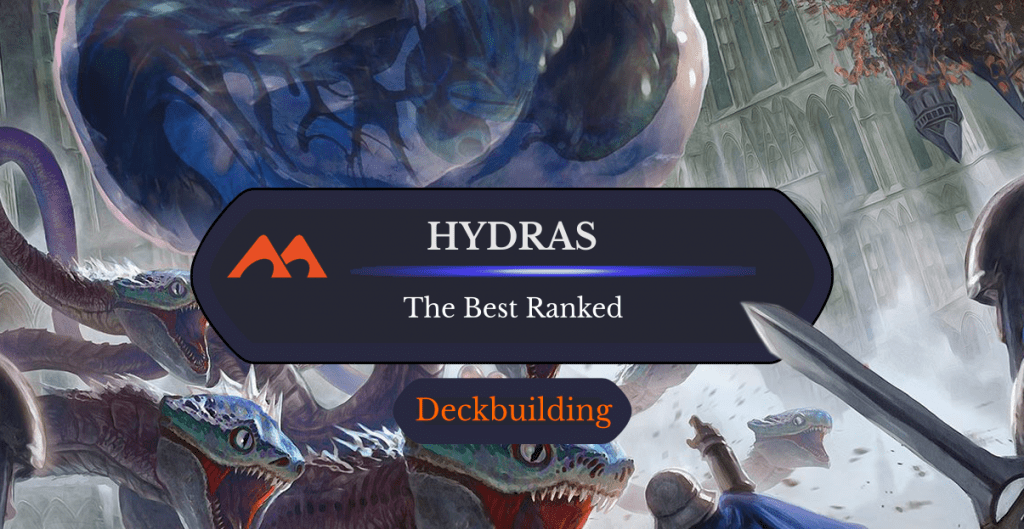
Hydroid Krasis | Illustration by Jason Felix
Mythology has always been a source of inspiration to MTG, especially Greek mythology. Hydras are no exception.
Hydras are powerful mythical creatures in Magic based on the legend that if you cut one of its heads off, two more grow in its place. This leads to +1/+1 counters and damage prevention being a common theme among hydras, and some of them even deal damage with their heads.
Looking for a hydra commander to build around, or some good beefy creatures to include in your decks? Well, look no further! Here’s everything you need to know about hydras, and the best among them.
What Are Hydras in MTG?
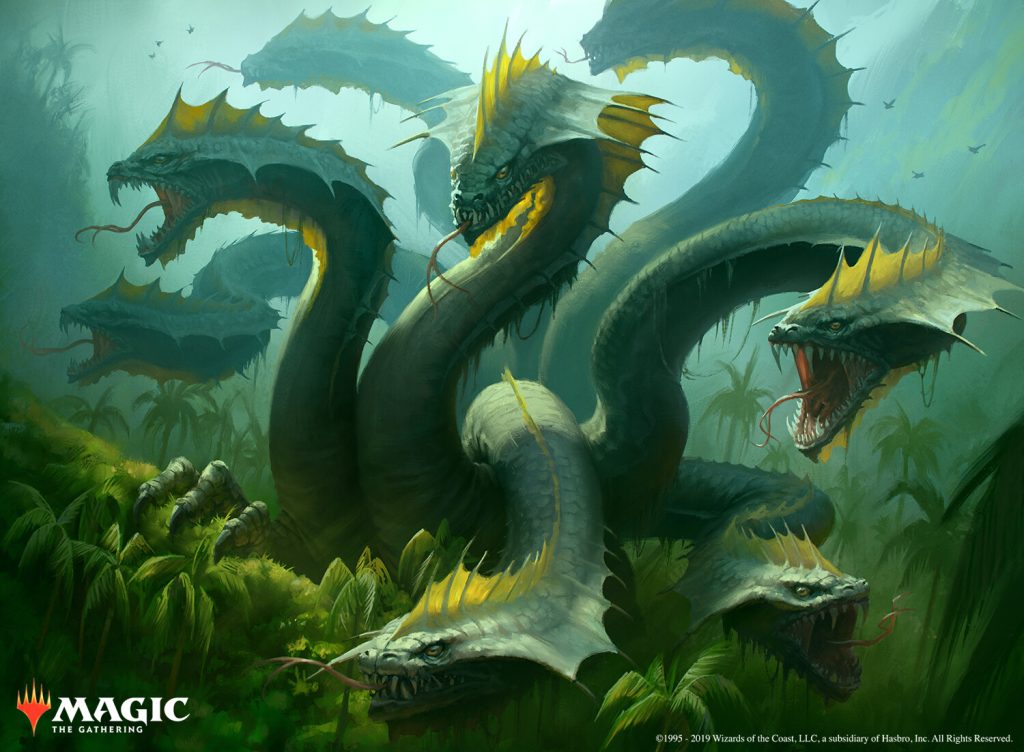
Wildwood Scourge | Illustration by Bryan Sola
Hydras are a creature type that are usually big and uncommon to rare rarity. Hydras are to green what dragons are to red or angels to white.
To convey the idea that the hydras have a lot of heads and that you need to cut all of them off to kill the creature, these creatures usually have +1/+1 counters that are removed when the creature is damaged. Other iterations have the hydra grow when mana is spent or when it takes damage. Hydras are usually big piles of power and toughness that sometimes have evasion like trample or flying, like Hydroid Krasis and Shivan Devastator.
Most hydras in Magic suffer from the “dies to Doom Blade” syndrome, meaning that they’re blanked by removal that says “destroy” or “exile.” So most hydras here are Limited bombs, but hard to make work in a Constructed deck. Other hydras have an enter- or leave-the-battlefield effect that raises their playability by a lot.
As of now, hydras’ primary color is green. Some hydras in the past were red which also fits since they have to do with dealing damage which is in red’s color pie. Some hydras are multicolor and it’s common to see 3-color hydras thanks to the popularity of Commander and the needs of Standard along with the themes of Limited.
There are almost 60 hydra cards printed in MTG, and today we’re taking a look at the best ones ever printed in each color. Ready? Let’s get started!
Best Red Hydras
#3. Ancient Hydra
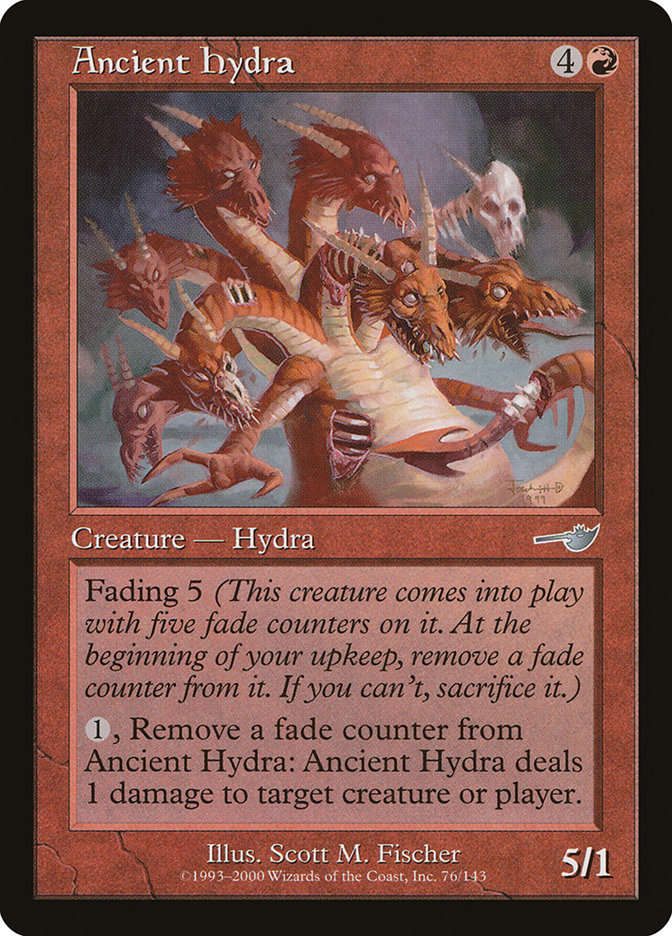
Ancient Hydra’s convoluted design (as is the case with most fading creatures) allows this 5/1 to distribute five damage if you have the mana for it, which make this creature a big Arc Lightning in disguise.
#2. Spitting Hydra
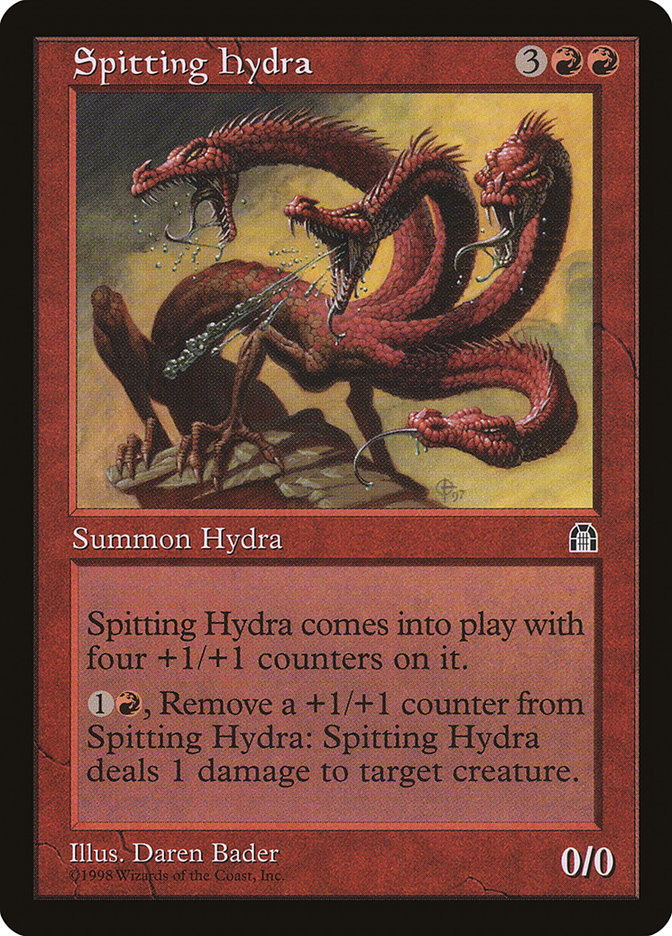
Spitting Hydra is similar to Ancient Hydra, but a 4/4 body is more well-rounded than a 5/1.
#1. Shivan Devastator
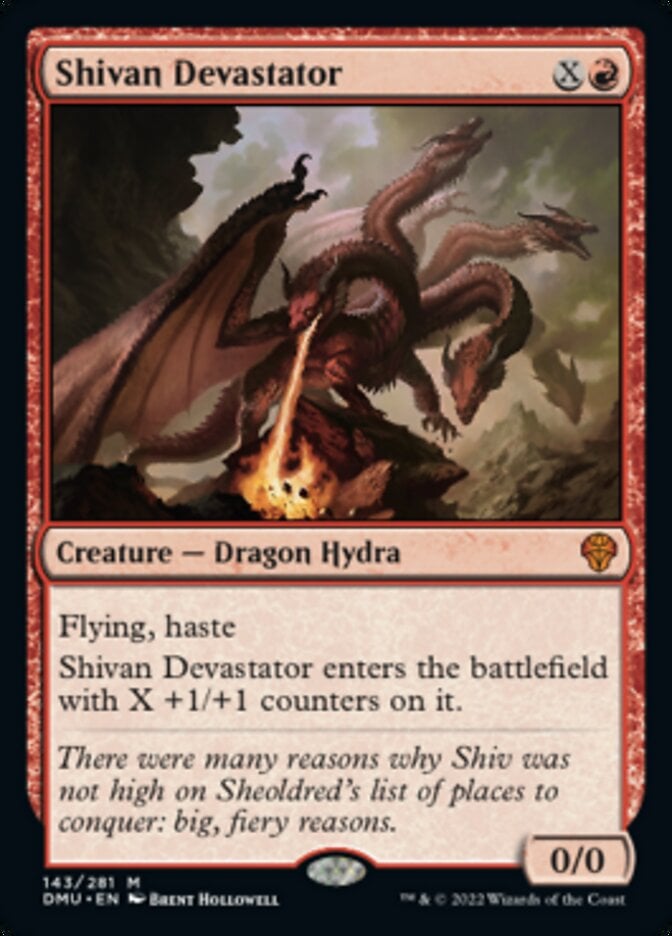
Shivan Devastator is almost like a Blaze with wings. This dragon hydra is efficient in almost any point of the mana curve, and it’s been a staple of aggressive red decks in Standard ever since it was printed.
This is a dragon and a hydra, two well-supported tribal decks in EDH. You can also play this in decks that care about the damage dealt to an opponent like Rakdos, Lord of Riots.
Best Green Hydras
#24. Hooded Hydra
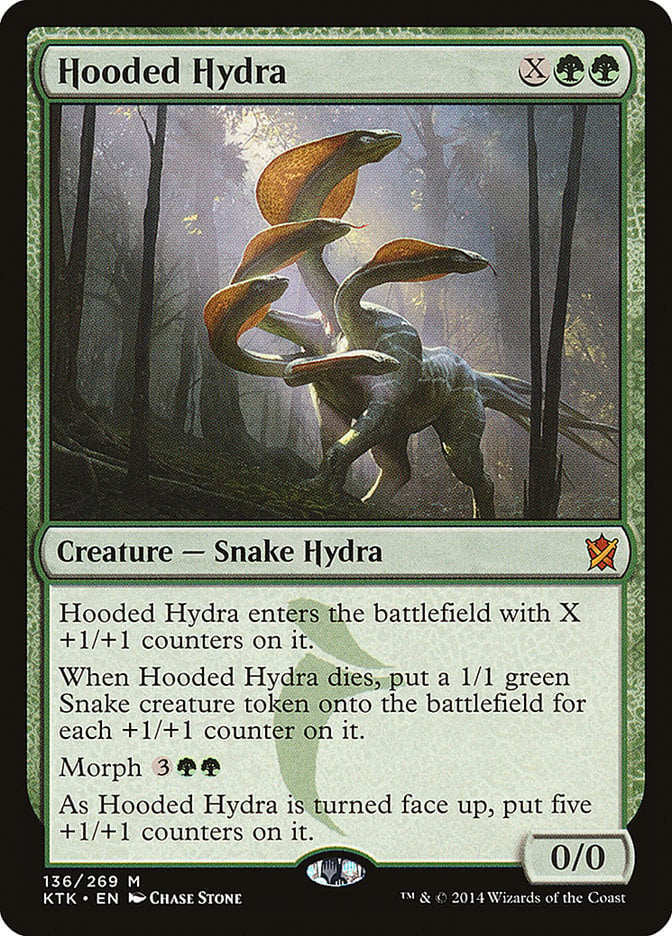
Although somewhat inefficient for Constructed, Hooded Hydra is nice if you have a lot of mana. It’s also great as a Limited bomb. Morph is the fastest route to playability if it survives since five mana nets you a 5/5 that converts into five 1/1s. Double that if Doubling Season is involved.
#23. Mistcutter Hydra

Mistcutter Hydra saw Standard play out of the sideboard against blue decks, and haste was a big reason why. R&D wanted a hydra to be playable so badly and this one made the cut.
#22. Phyrexian Hydra

I don’t think Phyrexian Hydra was played in Constructed because decks with infect are usually more explosive and want lower drops. But hey, it’s a 7/7 with infect for five, I guess?
#21. Briar Hydra
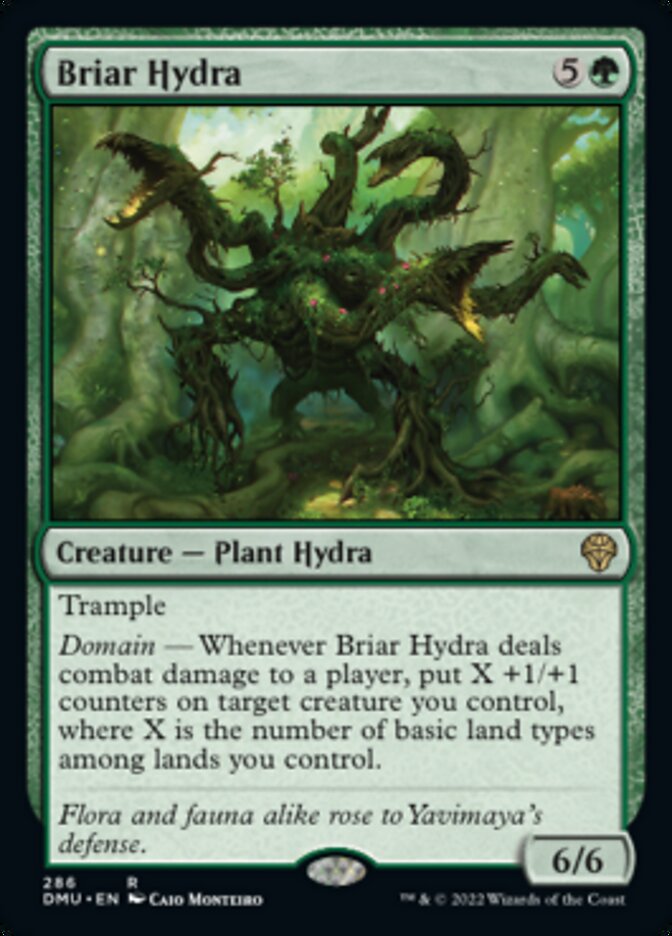
Briar Hydra is a baseline Colossal Dreadmaw, but it has massive upside when it deals any combat damage to a player. In decks with 3+ colors with +1/+1 counter synergies, it will be fairly easy to put 3 or 4 +1/+1 counters on a creature each turn, and you should really have a good double strike or lifelink creature around to benefit from the extra counters.
#20. Ramunap Hydra
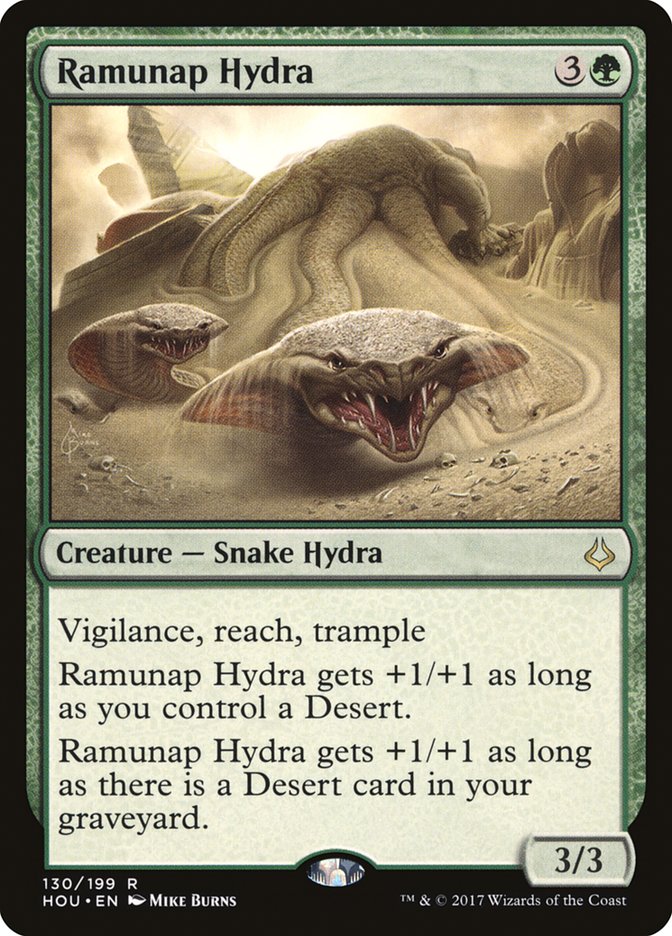
Ramunap Hydra can be a 5/5 with vigilance, reach, and trample, which is a solid collection of abilities for only four mana. Still, it’s best to leave it in your Limited decks, where it's obviously very good.
#19. Stumpsquall Hydra
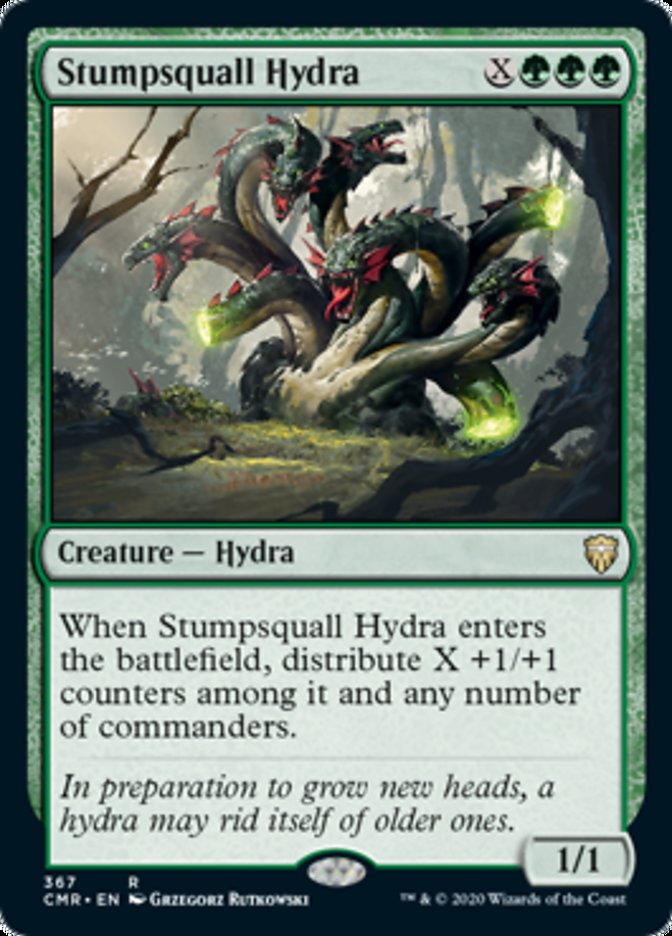
If your commander and deck care about +1/+1 counters then Stumpsquall Hydra is a solid inclusion. Otherwise, there are better hydras out there.
#18. Khalni Hydra
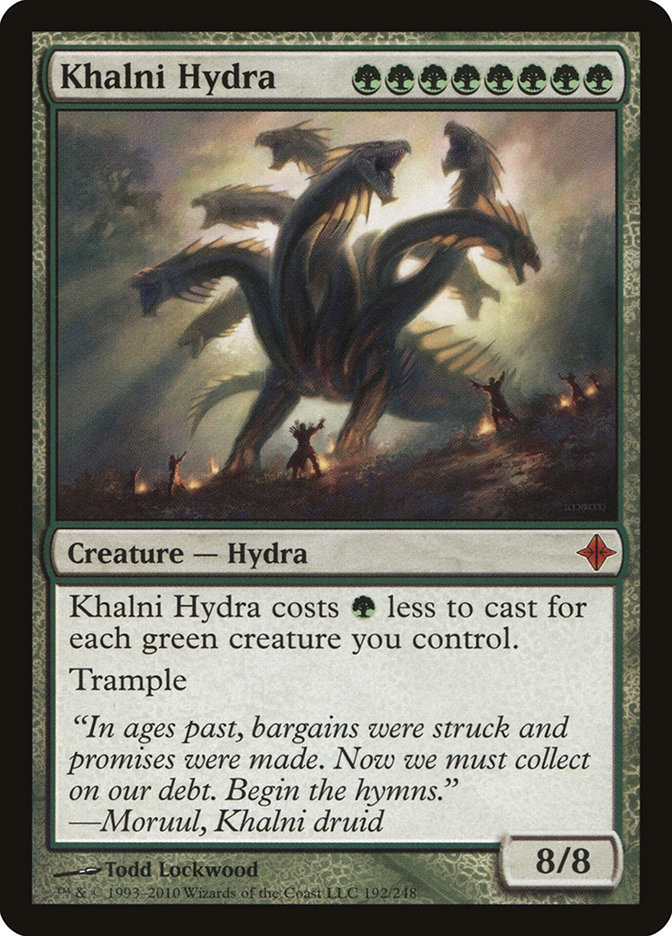
Unfortunately for Khalni Hydra, Ghalta, Primal Hunger exists. Still, the design for the time had a very mythic feel and devotion already existed in the form of “chroma.”
#17. Neverwinter Hydra
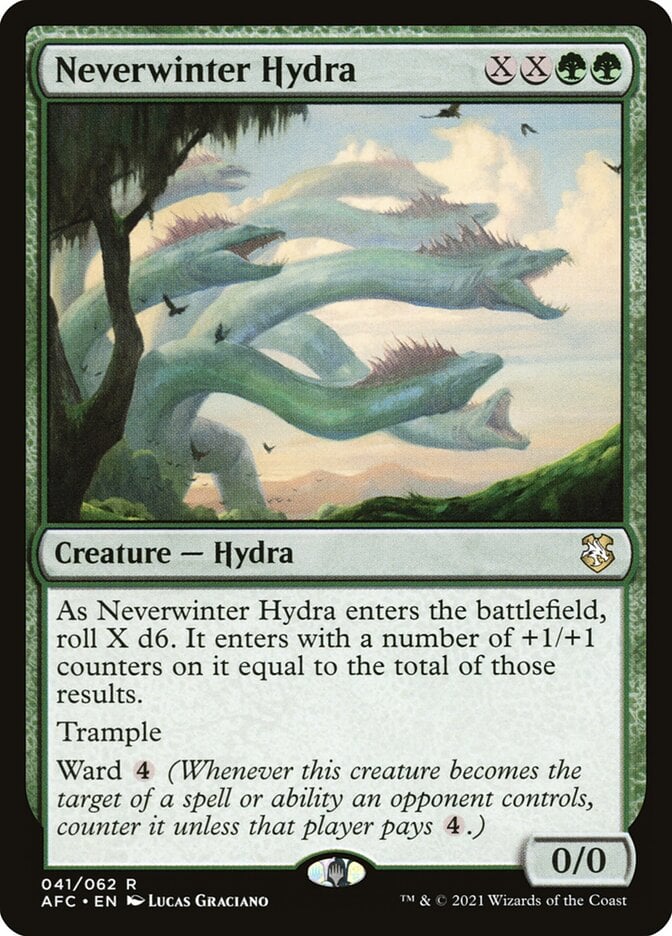
Neverwinter Hydra gets the nod for a couple reasons. It has ward 4 which helps a lot in surviving opposing removal. It also has a cool dice component (yes, luck-based). As of Forgotten Realms there are even some cards that that synergize with dice rolls.
#16. Rampant Rejuvenator
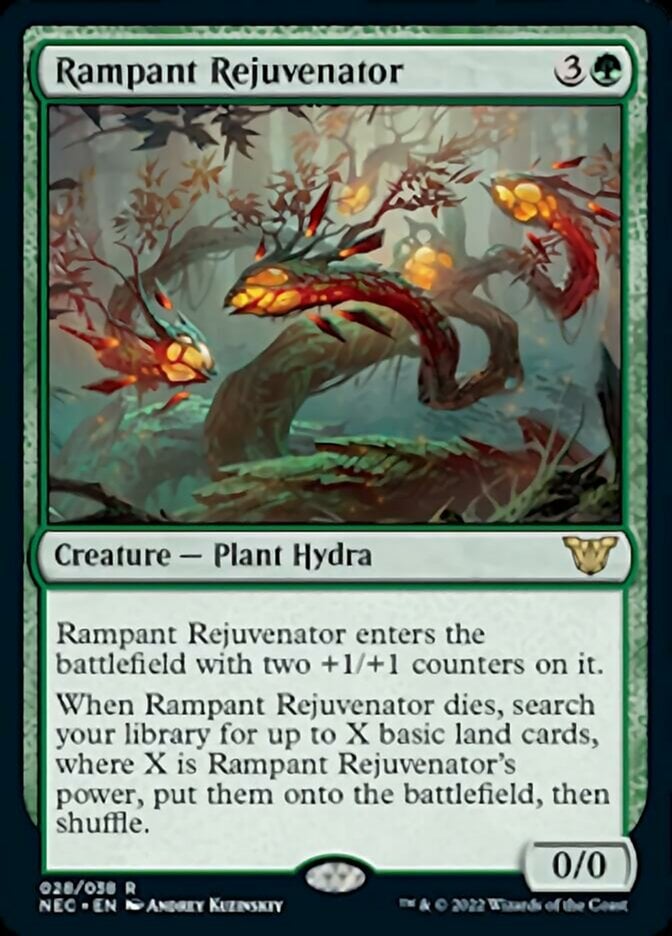
Rampant Rejuvenator can give you a bunch of lands on demand coupled with a sacrifice outlet, and you can make better use of this hydra by buffing its power or doubling its +1/+1 counters. If this card is a 4/4 or bigger, players won’t kill it or else they risk giving you 4+ lands.
You can exploit this creature by playing it, sacrificing it, and playing again every turn in a Muldrotha, the Gravetide deck.
#15. Hydra Omnivore
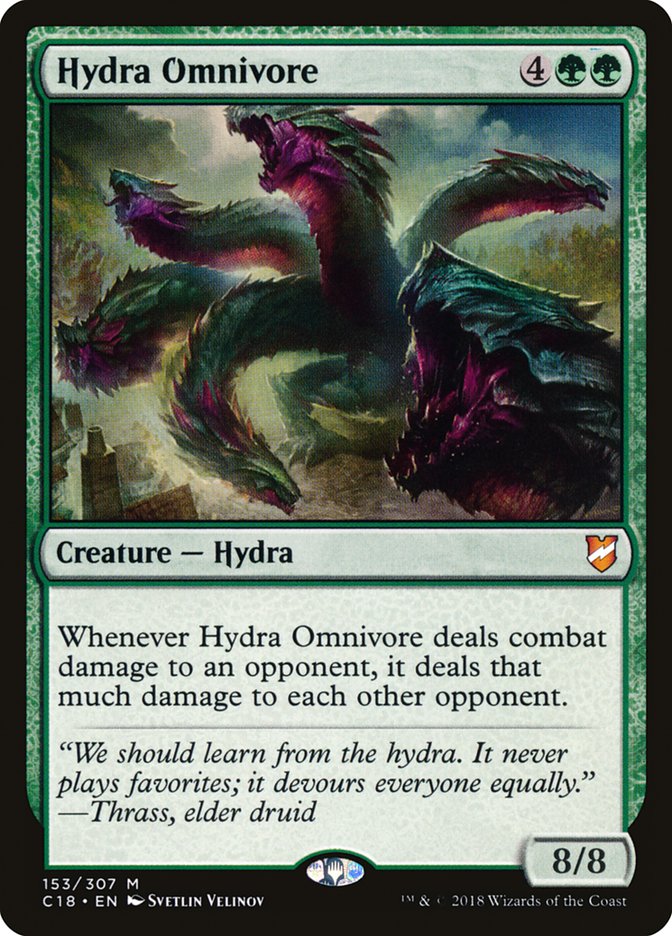
8/8 for six is a fine deal, and Hydra Omnivore is a big threat to punish all your opponents if you have ways to give it trample or evasion.
#14. Hydra Broodmaster
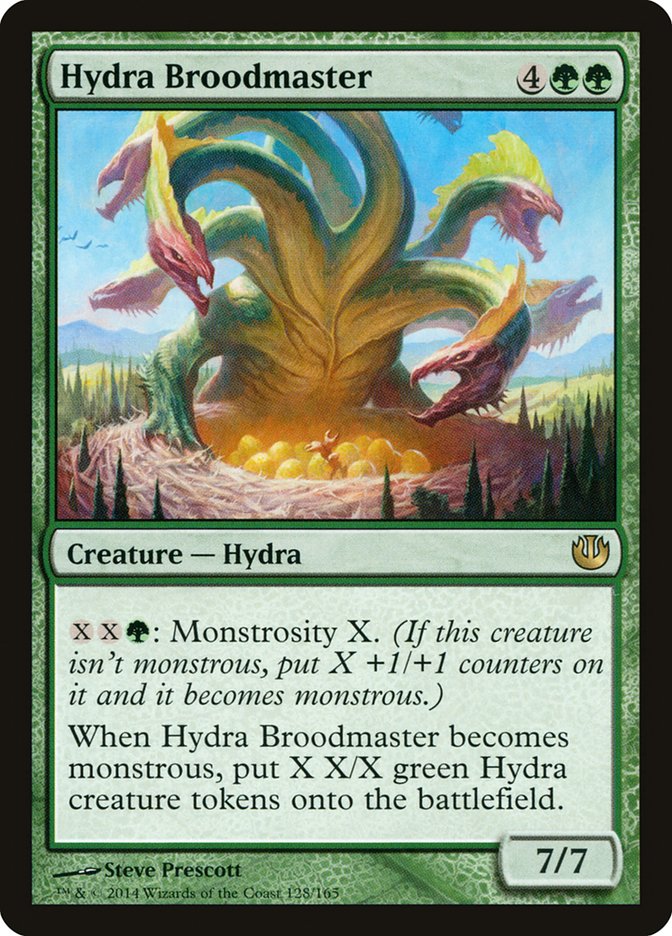
I found Hydra Broodmaster so cool when it was first revealed. 7/7 for six is good. Monstrosity is a cool mechanic and makes a lot of hydras. Limited bomb for sure, but it leaves a lot to be desired for Constructed applications.
#13. Kalonian Hydra

Kalonian Hydra saw some Constructed play and was part of the “let’s push creatures” movement. A 4/4 that attacks as an 8/8 is huge, and pairing it up with +1/+1 counters tribal gives you a very good incentive to play around with +1/+1 counter shenanigans.
#12. Whiptongue Hydra
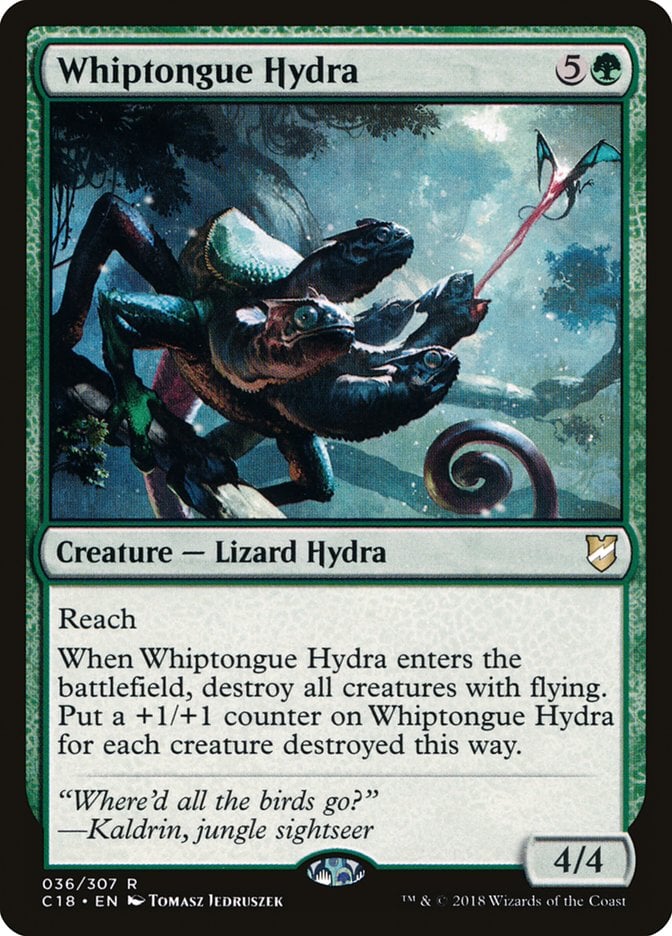
One of the more unique hydras, Whiptongue Hydra is a flier terminator. It’s great tech against your friends playing bird/spirit/tribal/fliers/angels-matter decks. I think you get the idea.
#11. Managorger Hydra

A storm hydra? Managorger Hydra naturally grows since it counts the spells from all your opponents, so you don’t need to go deep on spell casting and cantrips.
#10. Steelbane Hydra
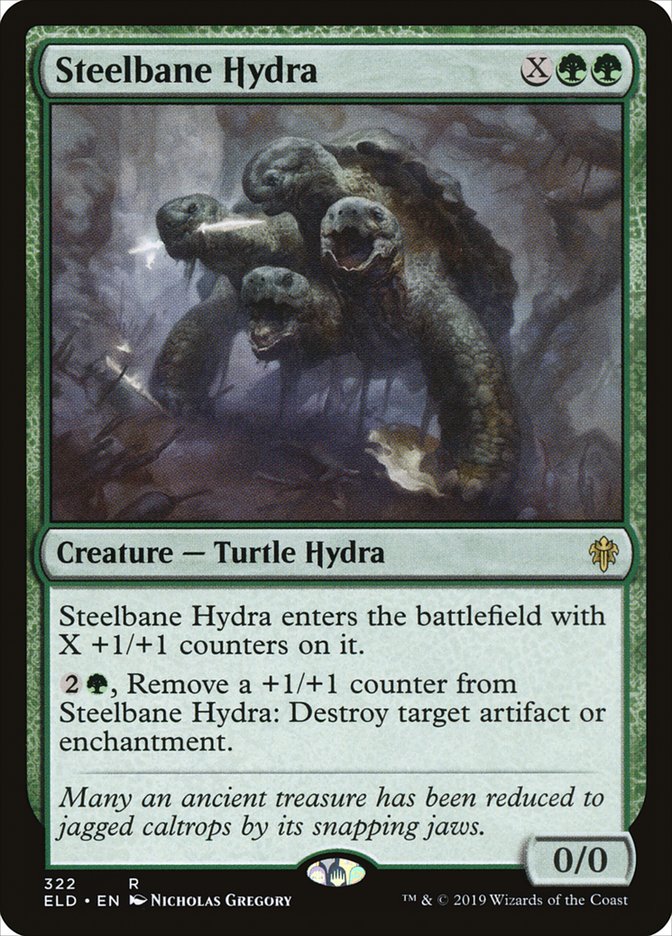
Besides being equal to almost all hydras, Steelbane Hydra does something very different in being a Naturalize. It has a lot of targets in a Commander deck.
#9. Polukranos, World Eater

Polukranos, World Eater saw play mainly as a 5/5 for four with an upside, and anything with two mana symbols is fair game in the green devotion decks. Plus it's a very real threat with big mana generating abilities.
#8. Voracious Hydra
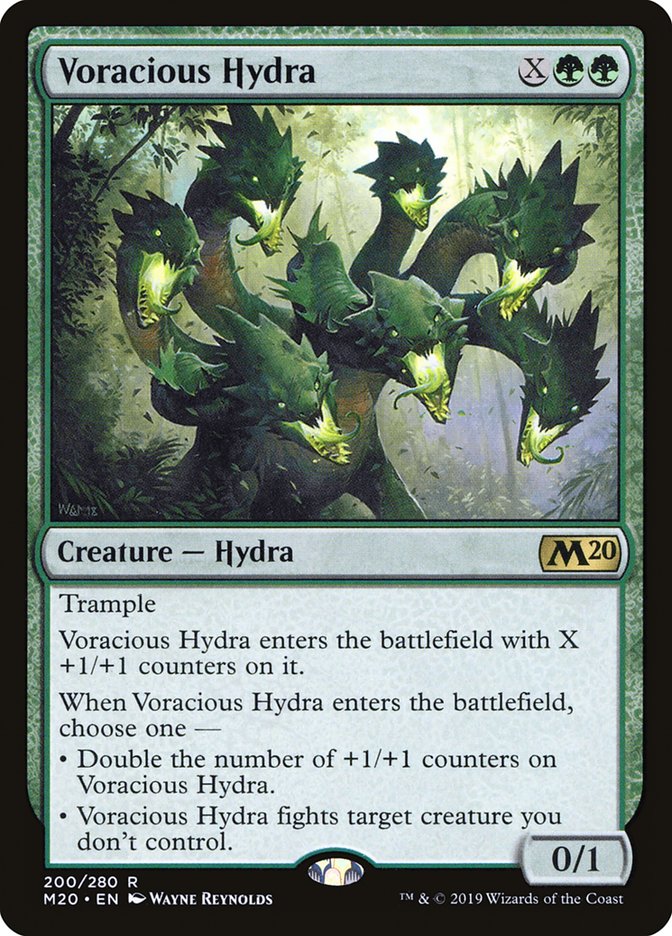
Having an immediate effect when entering the battlefield is a good way to be playable in Constructed, and Voracious Hydra has it. It either fights a small creature or becomes a big threat.
#7. Wildwood Scourge
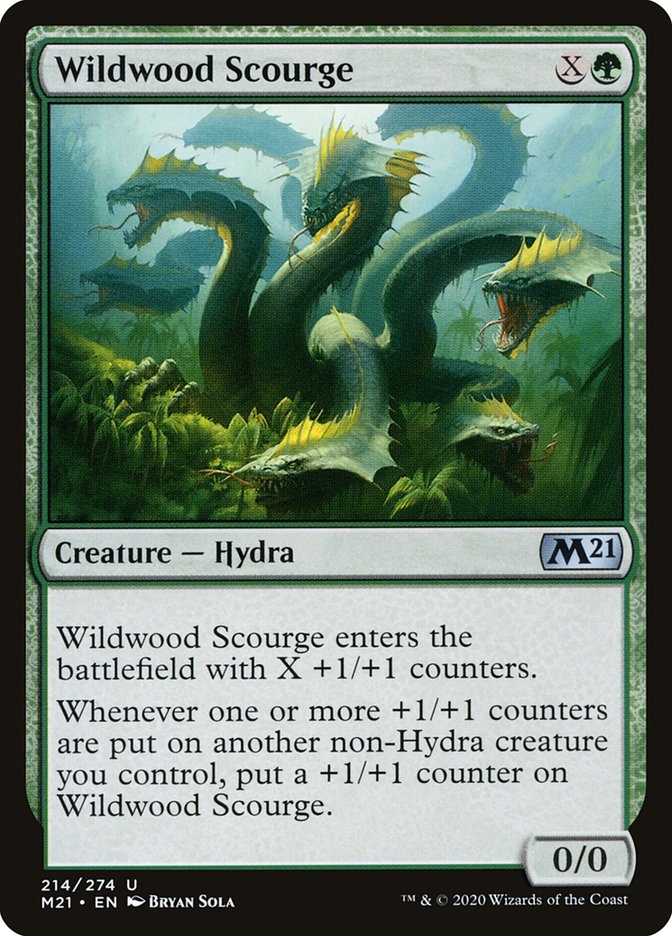
Wildwood Scourge was played for a while in decks that ran +1/+1 counters as a theme. Unfortunately the non-hydra clause (to avoid counting its counters) means that it’s not as interesting in a tribal hydra theme.
#6. Benevolent Hydra
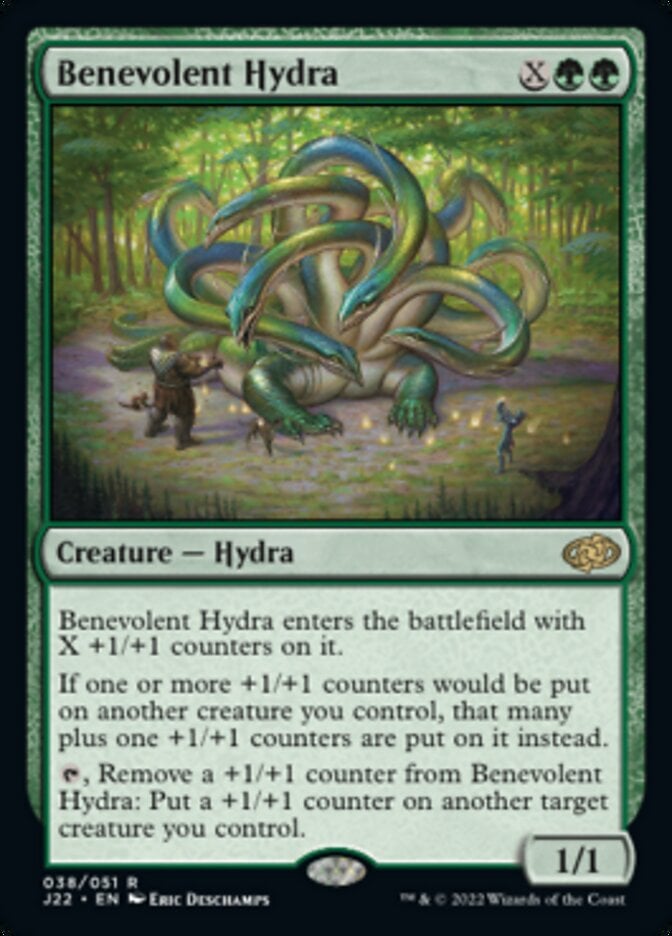
Benevolent Hydra combines the Hardened Scales ability with a large creature, and you can move counters around from your hydra to your other creatures. What’s more, you take one counter from your Benevolent Hydra every time you do that and put two counters on your other creature, increasing your overall resources.
Benevolent indeed.
#5. Ulvenwald Hydra
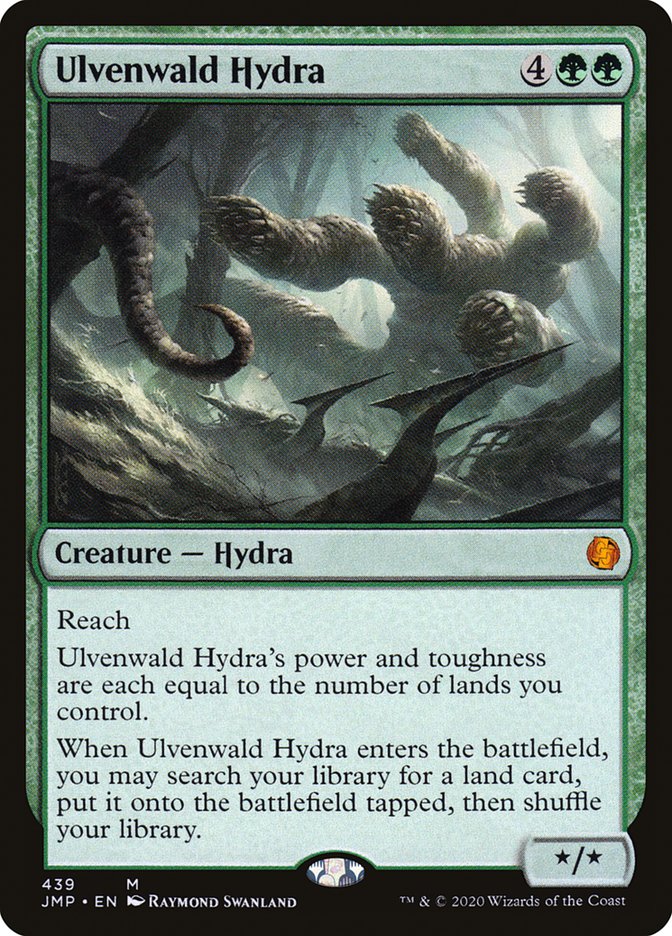
A good mix of abilities makes Ulvenwald Hydra worthy of consideration. It’s a big creature with reach, plus it ramps you and fixes your mana. Besides, it can tutor for any land in case you have special lands that need to be found.
#4. Apex Devastator
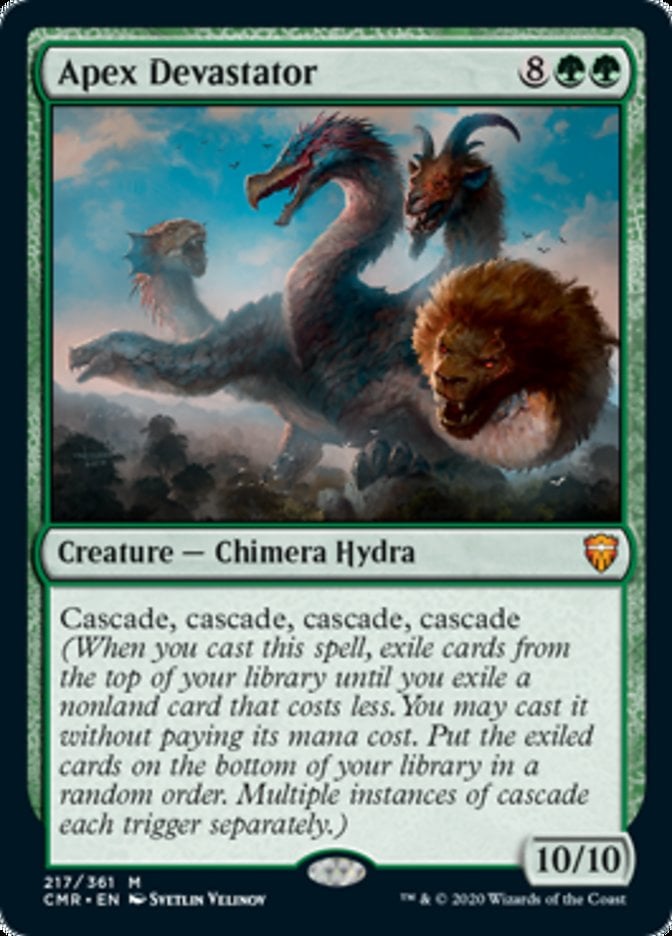
For ten mana you get a 10/10. You can get better deals out there, but four cascades means you’re getting at least four cards out of Apex Devastator. As unreliable as cascade can be sometimes, you’re getting at least four cards for your trouble. One of the best incentives to ramp out there.
#3. Bristling Hydra

Bristling Hydra was played a lot in Kaladesh Standard’s energy decks as a difficult threat to remove. It’s a 4/3 that survives the first removal by itself, and it’s better if you have energy going. A good threat in general.
#2. Gargos, Vicious Watcher
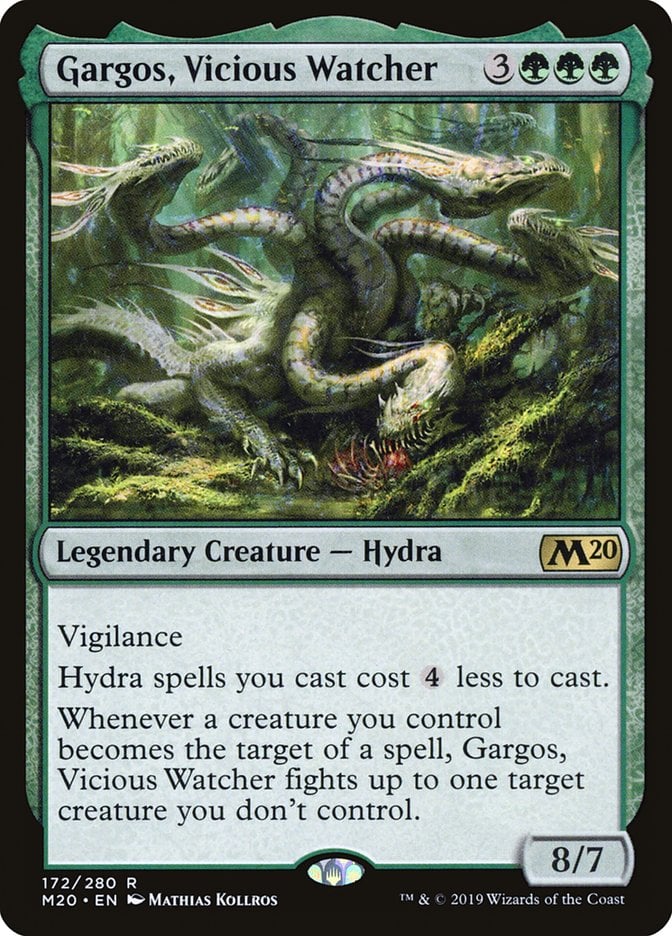
One of the few hydra lords out there, Gargos, Vicious Watcher is powerful. An 8/7 creature with vigilance for six is very good and your opponent will think twice before pointing removal spells at your creatures. One of the most interesting commanders to build a hydra deck around.
#1. Genesis Hydra
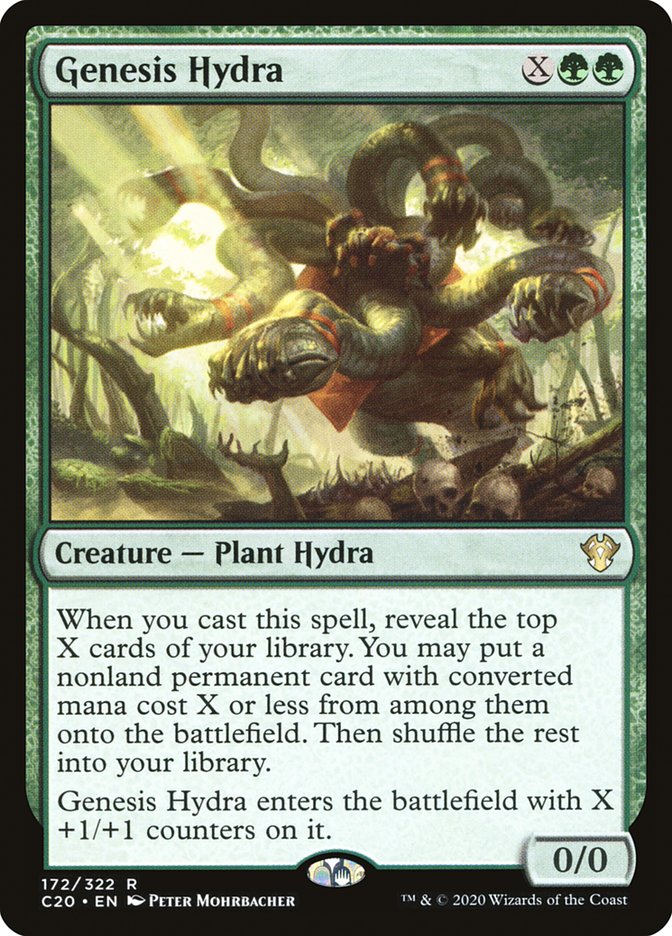
Genesis Hydra was one of the first Constructed-playable hydras. It was one of the key pieces in the monsters/devotion deck in Theros’ Standard. Spend a lot of mana, make a big threat, and gain another card in the process.
Best Multicolored Hydras
#11. Phytohydra
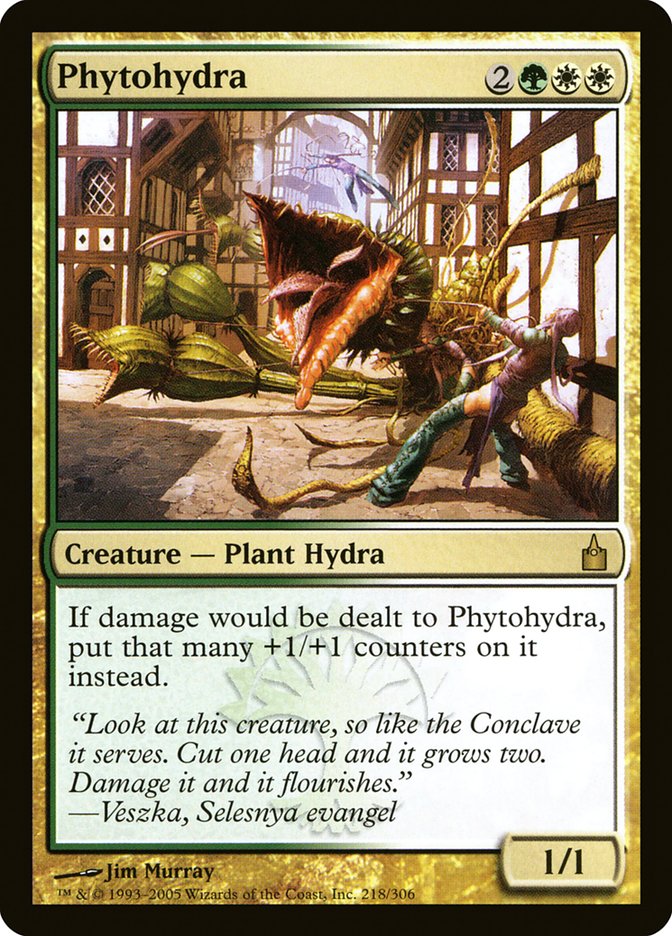
Phytohydra is a relic of MTG’s past as the only Selesnya () hydra here. A 1/1 for five is bad but it basically can’t die by damage. If it blocks a 5/5 it becomes a 6/6, so attacking into it is heavily discouraged.
#10. Gyrus, Waker of Corpses
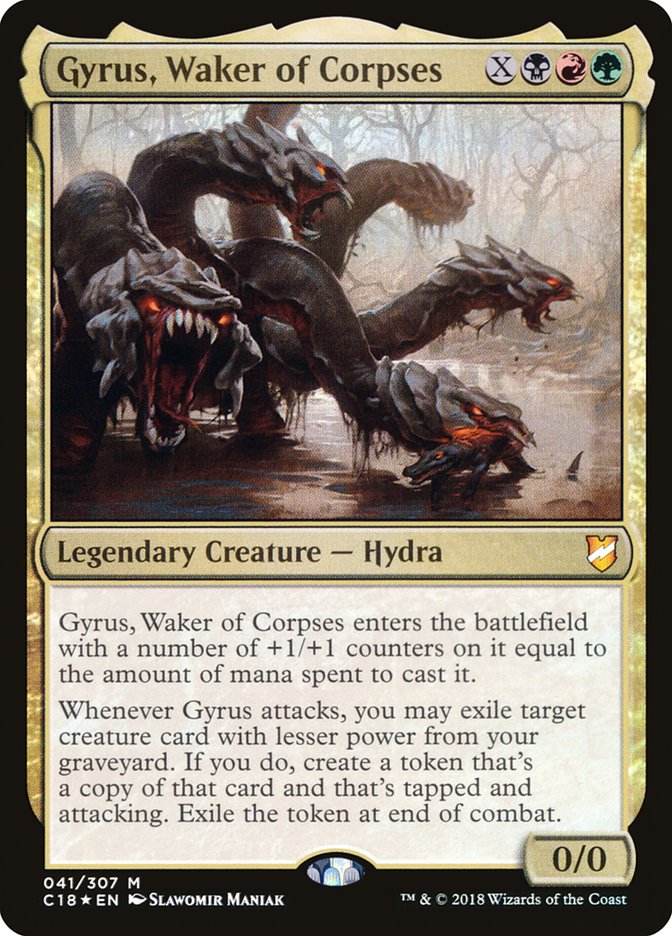
As a commander, Gyrus, Waker of Corpses requires self-mill and a lot of small value creatures, preferably with enters- and leaves-the-battlefield abilities. Plus a lot of ramp so that it can be cast for a huge X to be more effective.
#9. Zaxara, the Exemplary
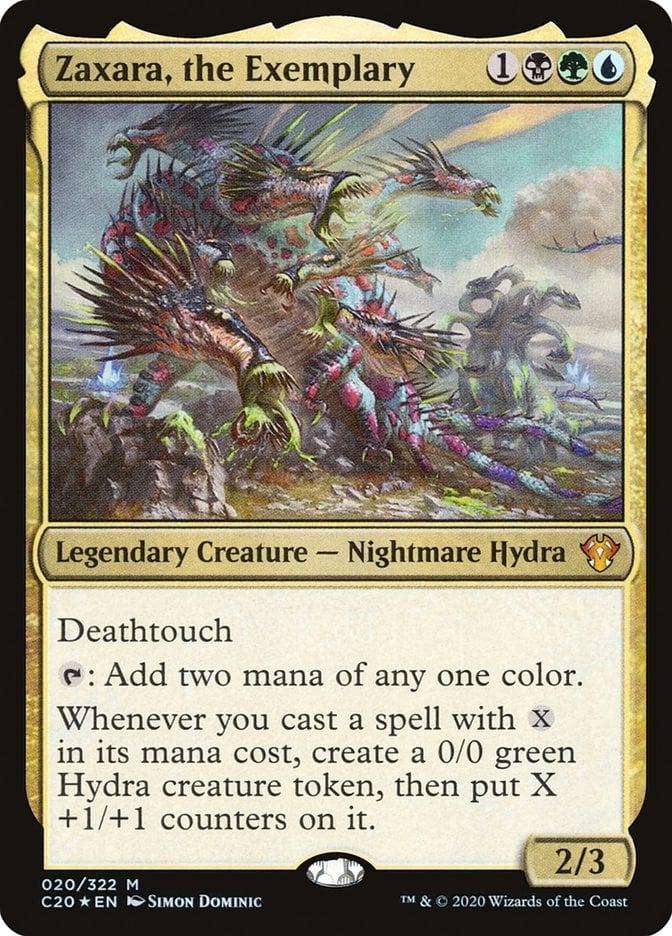
Zaxara, the Exemplary does a lot of things a hydra tribal deck wants. It’s in three colors with access to hydras, it generates two mana of any color, and it makes a little one whenever you cast a spell with X. So you want to ramp your mana and put a lot of powerful X spells on your deck.
#8. Savageborn Hydra
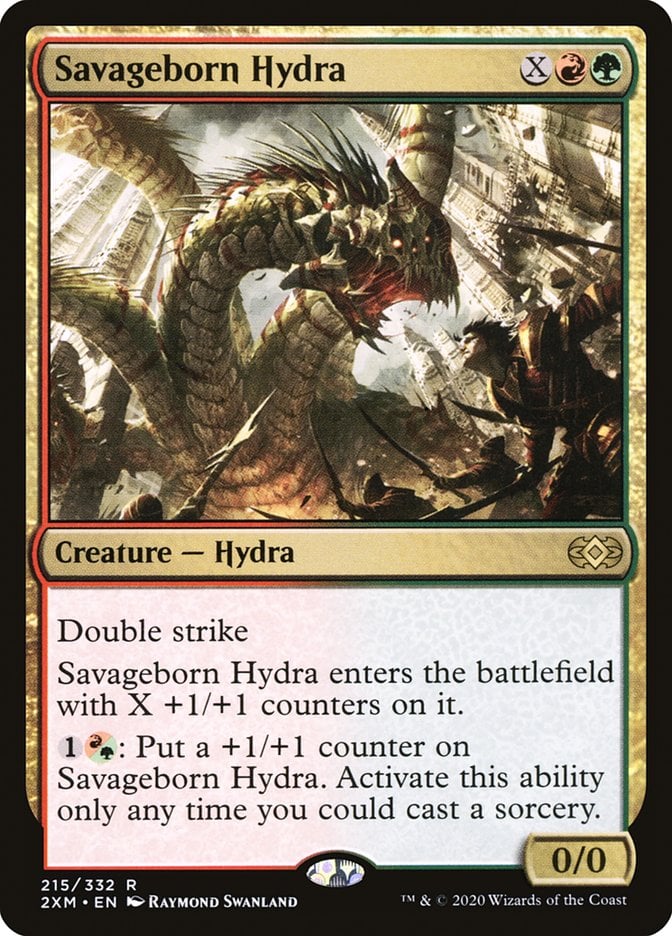
Very similar to Apocalypse Hydra, the double strike part makes a big difference. Savageborn Hydra is softer to removal because it can’t damage anyone, but one hit can be lethal.
#7. Apocalypse Hydra
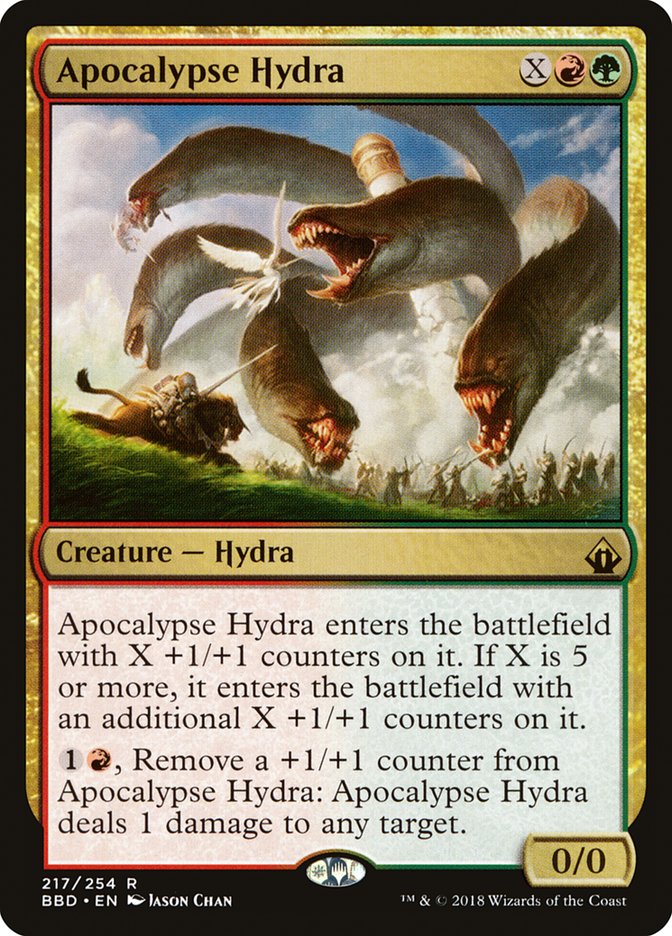
Apocalypse Hydra is a good reason to ramp, because for seven mana you get a 10/10, which is already powerful. And with spare mana the damage can be dealt to any target. Untapping with this much power is very frightening.
#6. Darksteel Hydra

Although it exists only on MTG Arena since as an Alchemy card, Darksteel Hydra is a powerful hydra. It’s got synergies with oil counters and counters in general, it protects itself, and you get some cards when it ETBs.
You can cast it for as low as four mana and get a mana rock and a Darksteel Plate to further protect your commander.
#5. Grakmaw, Skyclave Ravager
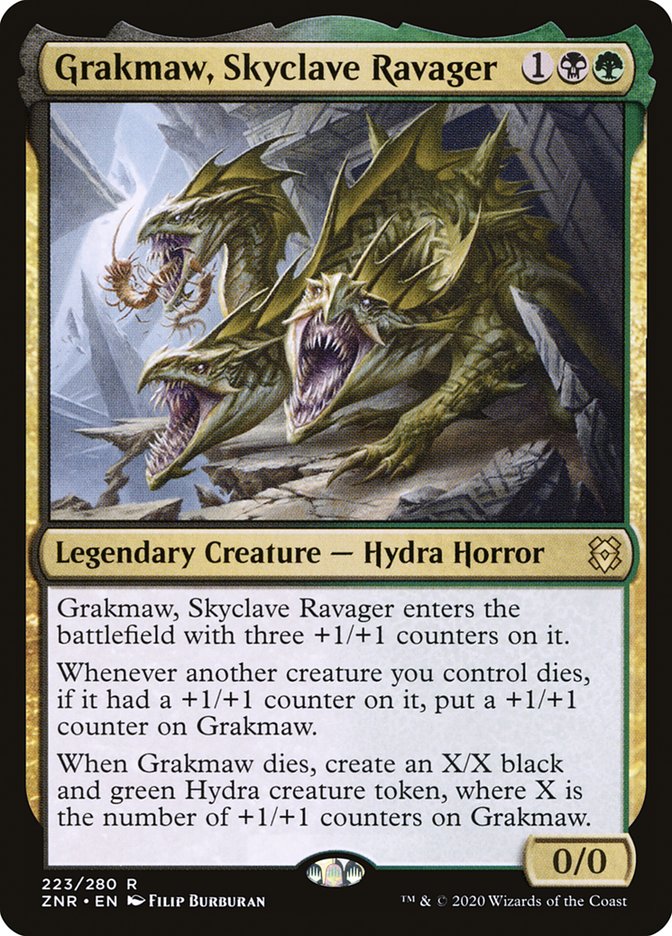
Grakmaw, Skyclave Ravager is an interesting card that sees Constructed play here and there. When all your creatures naturally have +1/+1 counters it becomes a house and even leaves a corpse behind.
#4. Polukranos Reborn / Polukranos, Engine of Ruin
Polukranos Reborn is a nicely-stated creature as a 4/5 with reach for , and you can transform it into a Wurmcoil Engine-style creature that gives the wurmcoil death trigger ability to all your hydras. You can play Polukranos Reborn as a Selesnya () hydra commander, or as a card in a hydra tribal Commander deck.
#3. Polukranos, Unchained
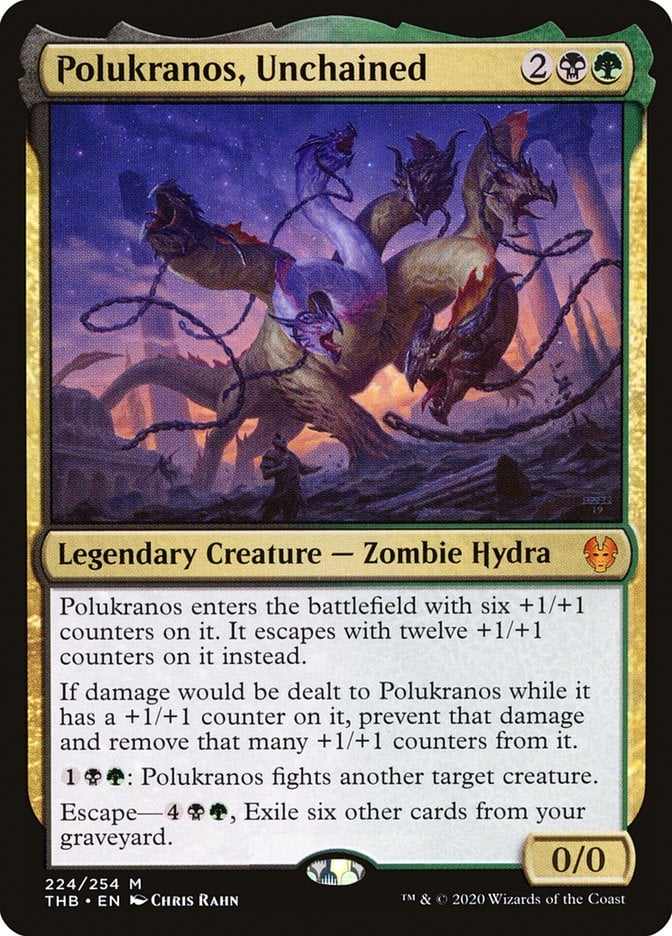
Another staple in its Standard, Polukranos, Unchained is a 6/6 for four which is a good rate these days, and it comes back as a 12/12 thanks to escape. The fight effect means that Polukranos is never just a “big beater,” it’s also a killer. This was the card you wanted to mill against Rogue decks that wanted to mill you to death.
#2. Progenitus
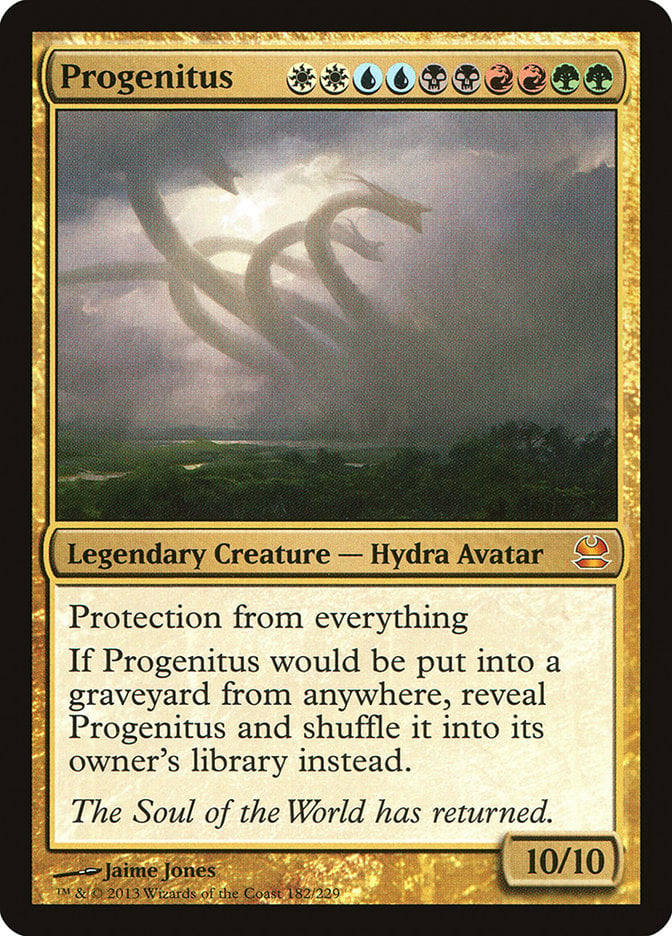
The soul of the world has protection against everything, and it’s probably the only time this expression was used on a MTG card. But Progenitus isn’t immune to wrath or sacrifice effects. It’s also very hard to cast.
Progenitus EDH decks are built in such a way that it’s cast, gains haste and some extra power, and then double strikes someone for lethal commander damage.
#1. Hydroid Krasis
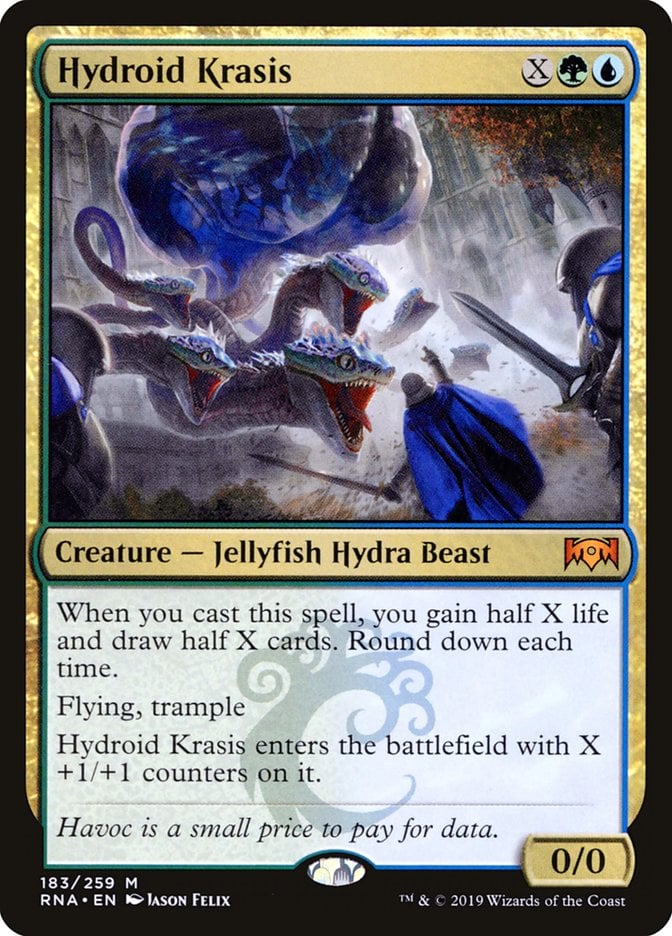
A card that defined Standard and became one of the most interesting Simic cards, Hydroid Krasis is never bad. It’s usually played as a 4/4 for six that draws you two cards and gains you two life.
It becomes even more powerful in ramp deck. The interesting part is that the lifegain and card draw is on cast, not on resolution. This makes Krasis a good card against aggro, control, and midrange decks.
Best Colorless Hydra
#1. Clockwork Hydra
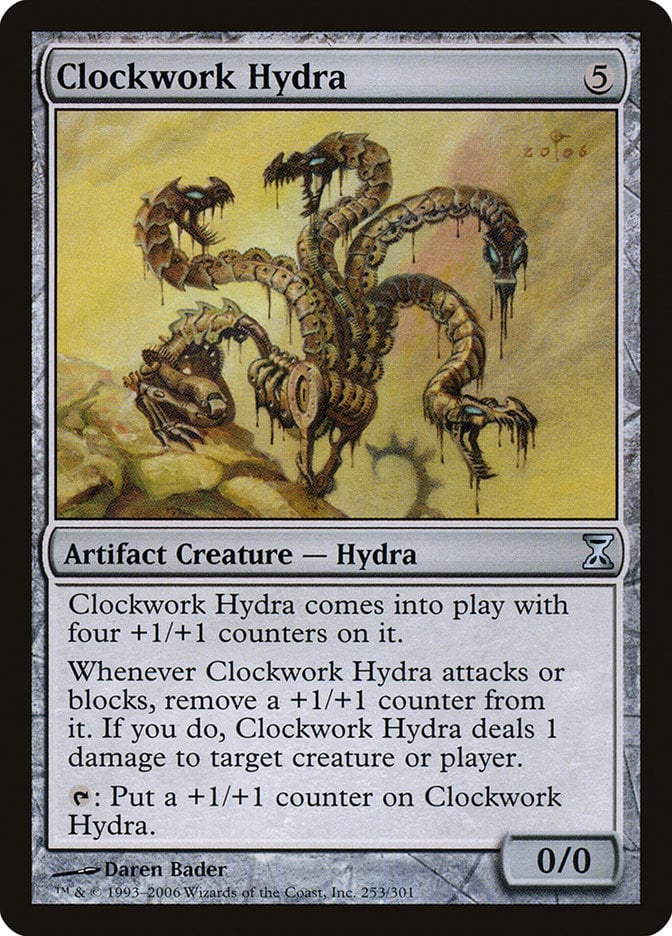
The only hydra printed in colorless, Clockwork Hydra is a 4/4 for 5 which is not very good, but in Limited it can kill small creatures and in a board stall it can grow. It’s also fine on defense because it can block and tap to grow at the same time.
Best Hydra Payoffs
Hydras in MTG come with a variety of effects, mainly +1/+1 counters and ramp/mana sink. During Theros’ Standard some green devotion decks could produce a lot of mana thanks to Nykthos, Shrine to Nyx. Another thing to note is that cards that usually work well in hydra decks are green based, so there aren’t a lot of incentives to run other colors except to splash a Simic, Gruul (), or Golgari () hydra.
Gargos, Vicious Watcher

As far as hydra lords go costing four less to play is a big incentive. Gargos, Vicious Watcher’s ability extends to all creatures, including hydras.
Grakmaw, Skyclave Ravager

Grakmaw, Skyclave Ravager incentivizes you to have a lot of creatures with +1/+1 counters, which hydras usually have. It even creates hydra tokens when it dies.
Zaxara, the Exemplary

Zaxara, the Exemplary generates mana, which is awesome to cast big creatures, and it also creates hydras whenever you play a spell with X in its mana cost which a lot of hydras have.
Rosheen Meanderer
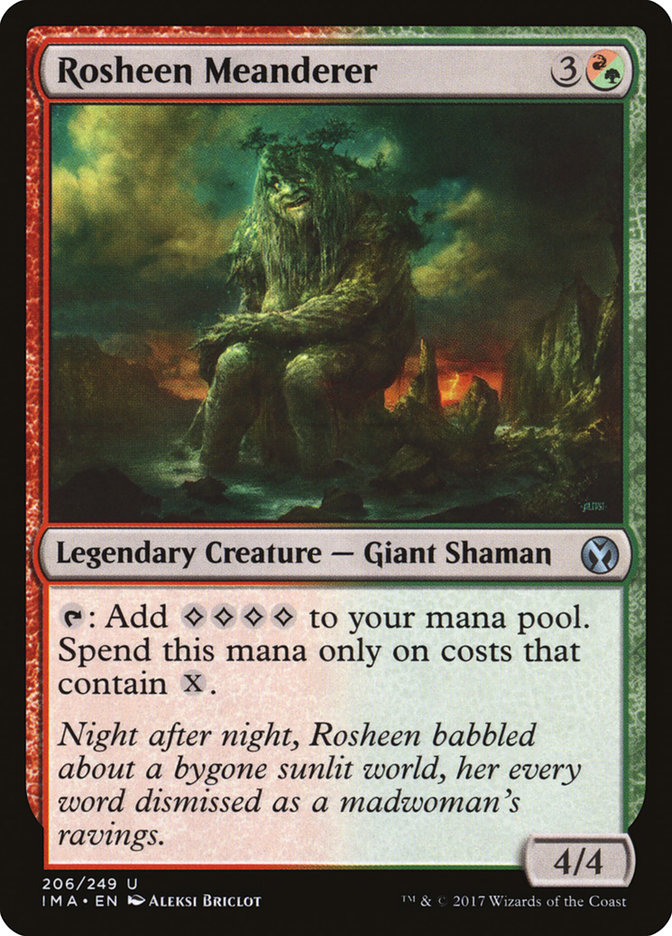
Rosheen Meanderer is another incentive to cast hydras with X in their mana cost.
Reyhan, Last of the Abzan
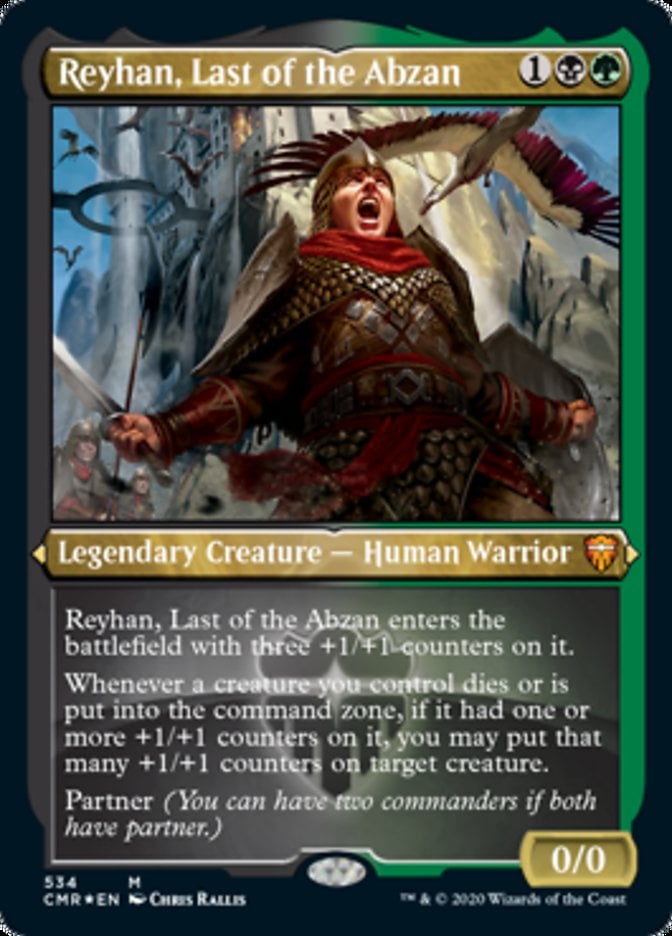
Reyhan, Last of the Abzan is a legendary Golgari hydra that cares about counters, which are on theme with hydras.
Doubling Season
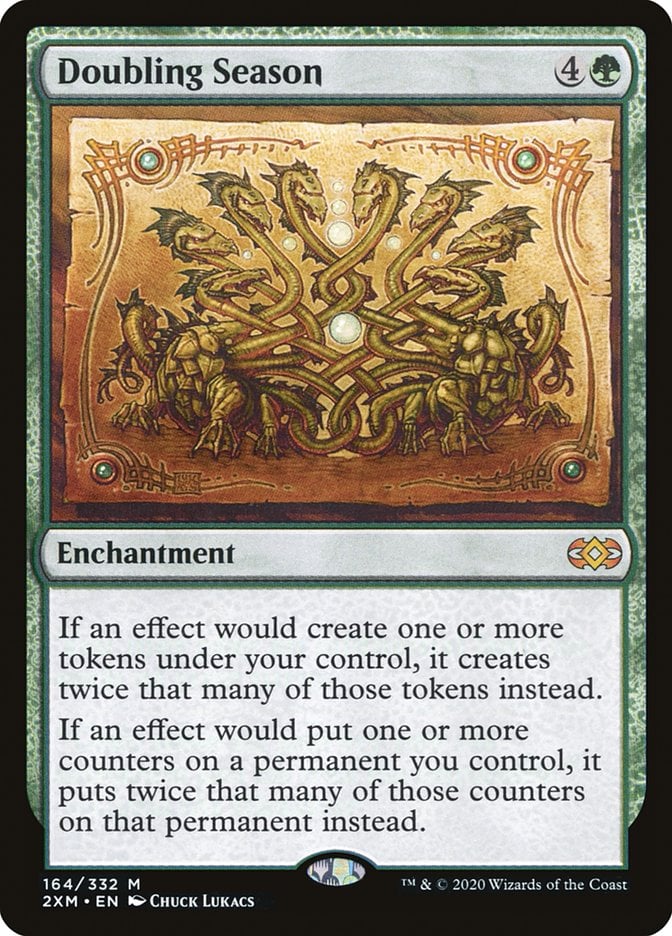
Hydra decks usually produce a lot of +1/+1 counters and creature tokens so Doubling Season is perfect.
Vorinclex, Monstrous Raider
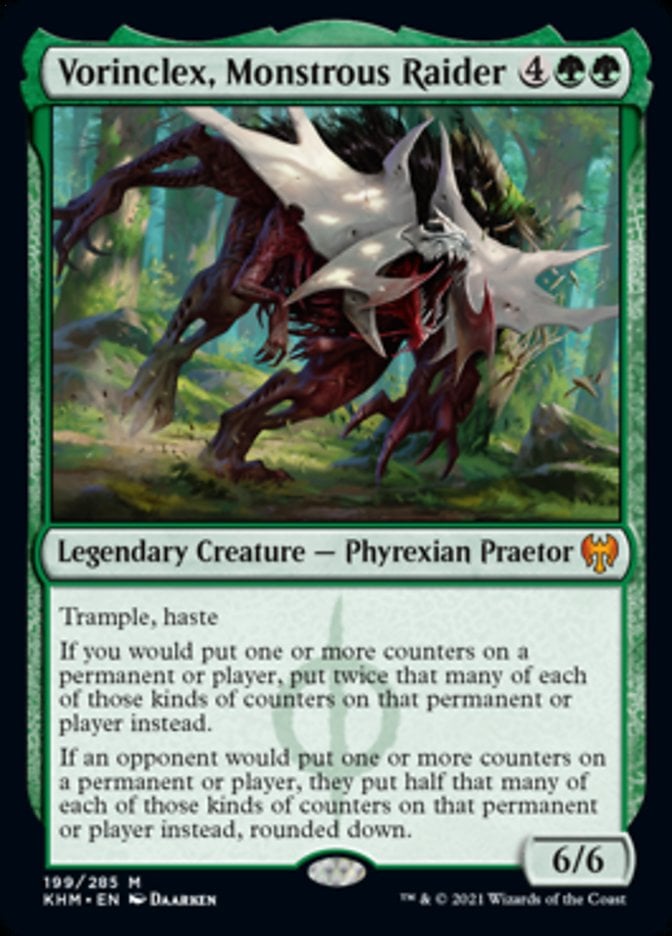
See Doubling Season above. Besides, Vorinclex, Monstrous Raider is a 6/6 trampler with haste.
Hardened Scales
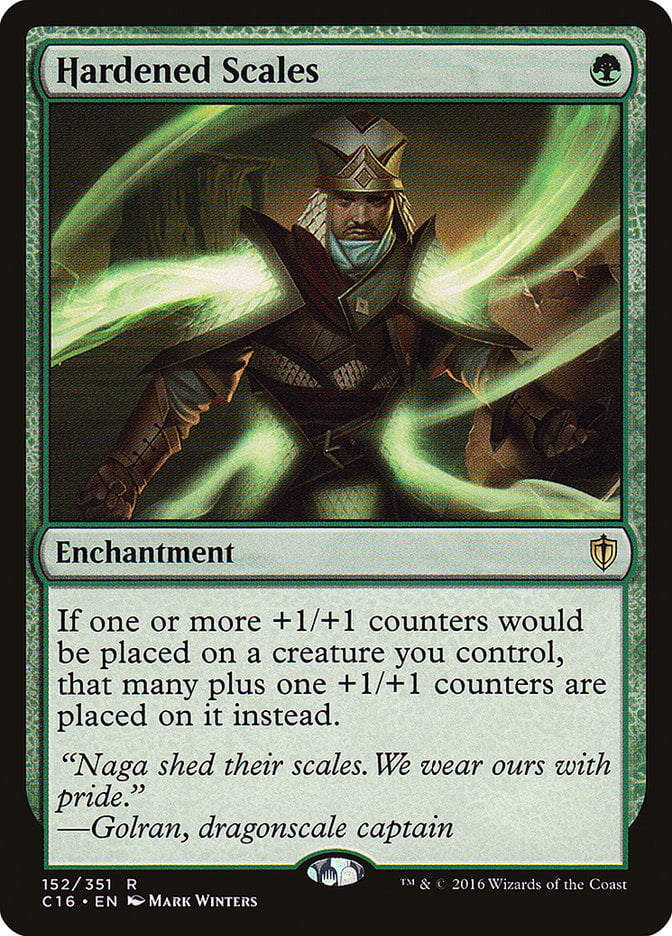
Each hydra enters the battlefield with an extra +1/+1 counter thanks to Hardened Scales, so it’s practically a hydra lord.
Kodama of the West Tree
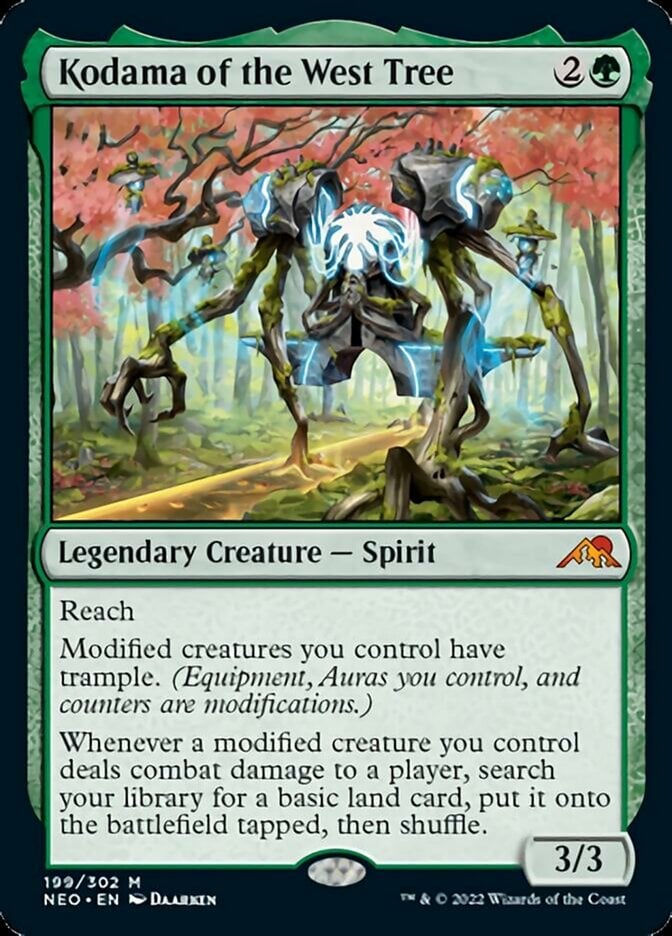
It’s not like almost all your hydra creatures will be a modified creature at some point, right? Give your big creatures trample and ramp when you hit the enemy with Kodama of the West Tree.
Garruk's Uprising
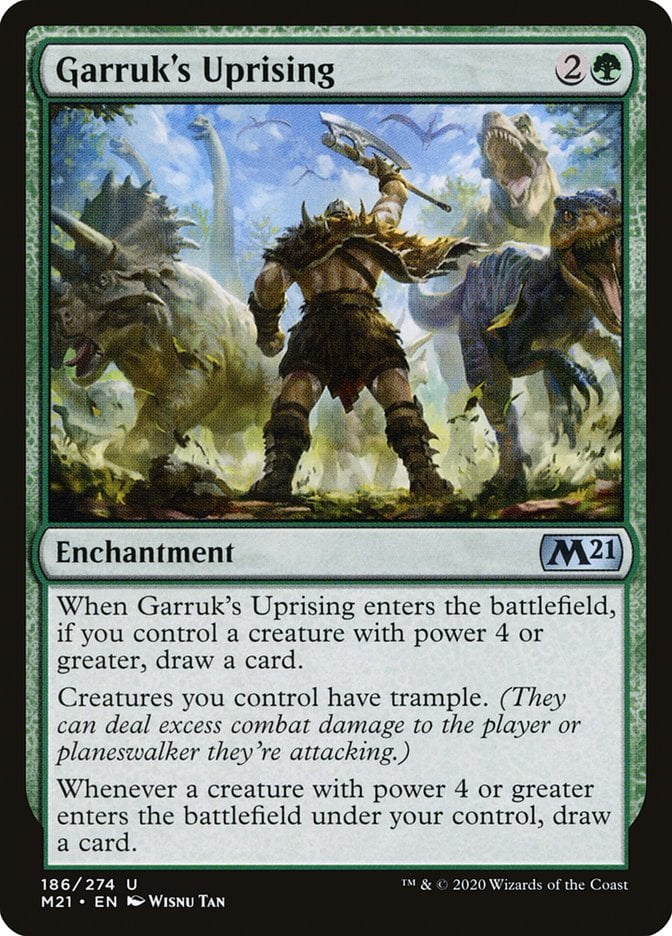
Garruk's Uprising lets you draw lots of cards and gives your big creatures trample.
Glorious Sunrise
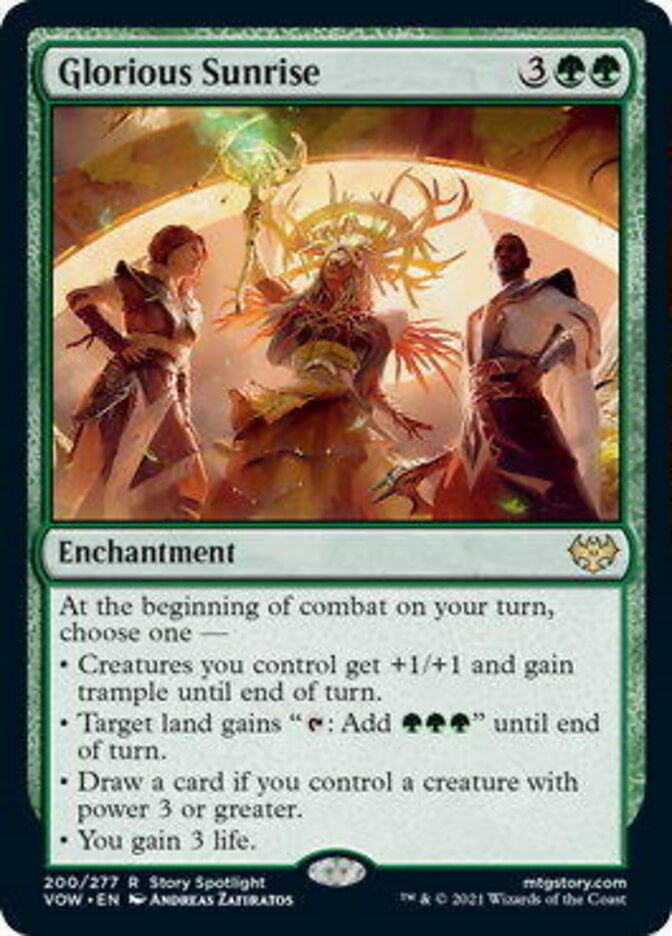
Glorious Sunrise does everything you want: gain life, draw cards, pump your creatures, or ramp.
Nykthos, Shrine to Nyx
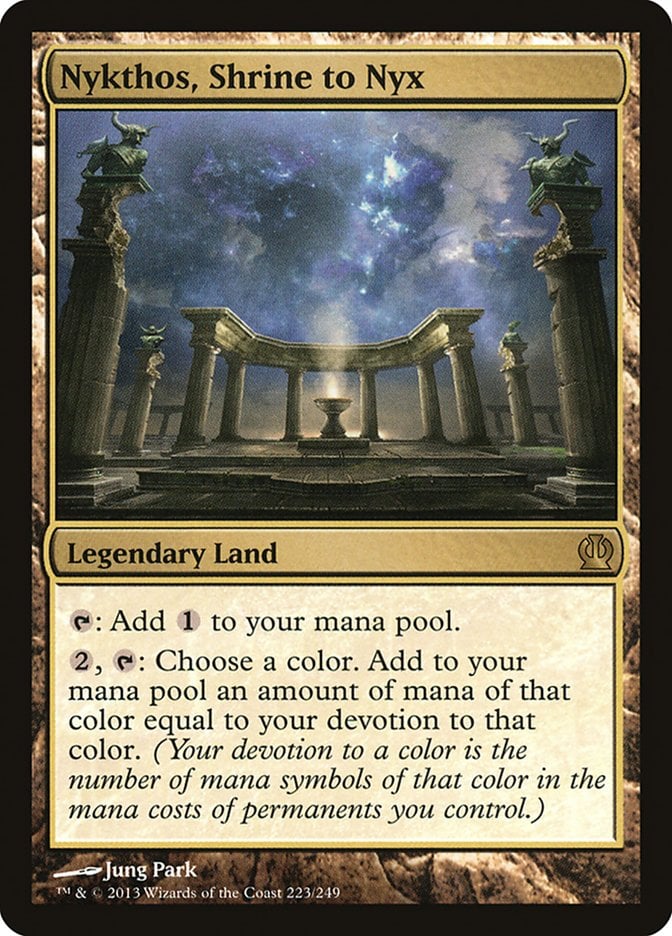
Nykthos, Shrine to Nyx can generate absurd amounts of mana, especially if your deck is base green which most hydras are.
Vanquisher's Banner
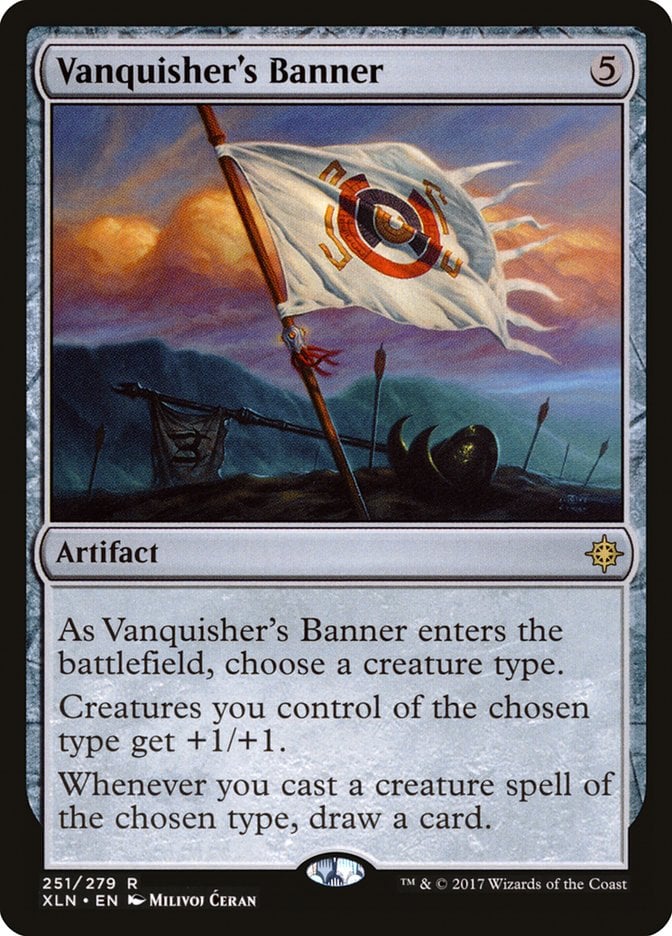
Generic tribal incentive is always good, and Vanquisher's Banner can be put to good use in any tribal deck.
Reyhan, Last of the Abzan

Reyhan, Last of the Abzan is a legendary Golgari warrior that cares about counters, which are on-theme with hydras.
Magus Lucea Kane

Magus Lucea Kane is a Temur () commander that cares about +1/+1 counters and allows you to copy a spell with X in its mana cost. That's a perfect fit for a deck filled with hydras, or a hydra commander.
Polukranos Reborn / Polukranos, Engine of Ruin
Polukranos Reborn, once transformed into Polukranos, Engine of Ruin, will make all your hydra non-token creatures die into two Hydra tokens. That helps a lot with the “Dies to Doom Blade” syndrome lots of hydras have.
Are Hydras Good in MTG?
There are a lot of good and playable hydras in Magic. Hydras usually appear at rare and are at least Limited bomb tier with a lot of them seeing Constructed play. A lot of hydras are very efficient at their mana value and a lot of them have X in their cost which scales with the game or allows you to spend more mana in their activated abilities.
What Legendary Hydra Commanders Are There?
- Gargos, Vicious Watcher
- Polukranos, World Eater
- Grakmaw, Skyclave Ravager
- Polukranos, Unchained
- Polukranos Reborn / Polukranos, Engine of Ruin
- Ulasht, the Hate Seed
- Gyrus, Waker of Corpses
- Zaxara, the Exemplary
- Progenitus
Is a Hydra a Dragon in Magic?
Hydras and dragons are two different creature types in Magic. Dragons aren’t hydras, and hydras aren’t dragons.
Wrap Up
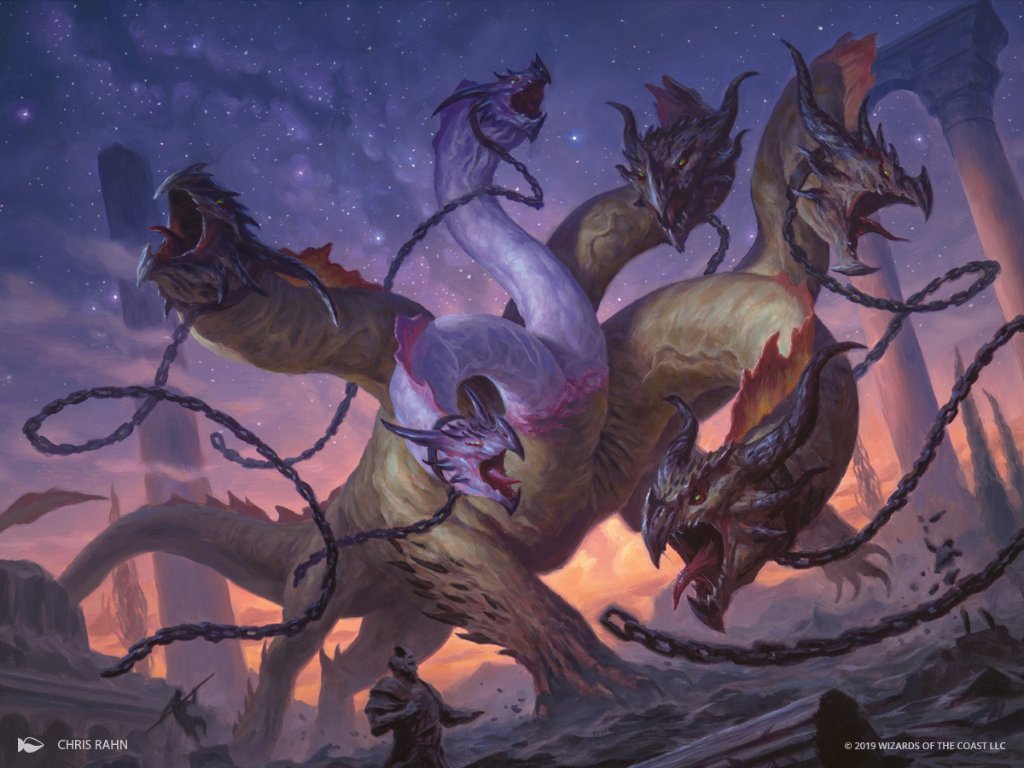
Polukranos, Unchained | Illustration by Chris Rahn
Hydras are definitely playable in MTG. It’s very important to get card advantage from other sources though since they’ll usually trade 1-for-1 with opposing removal. The play pattern of playing a huge monster in a turn is also complicated, making it easier for an opponent to get a tempo advantage. That being said, deckbuilders will have a blast playing with hydras and +1/+1 counters.
What’s your favorite hydra? Did I miss any that you think should be here? Let me know in the comments down below or over in Draftsim’s Discord.
That’s all from me for now. Best of wishes to all of you and I’ll see you in the next one!
Follow Draftsim for awesome articles and set updates:

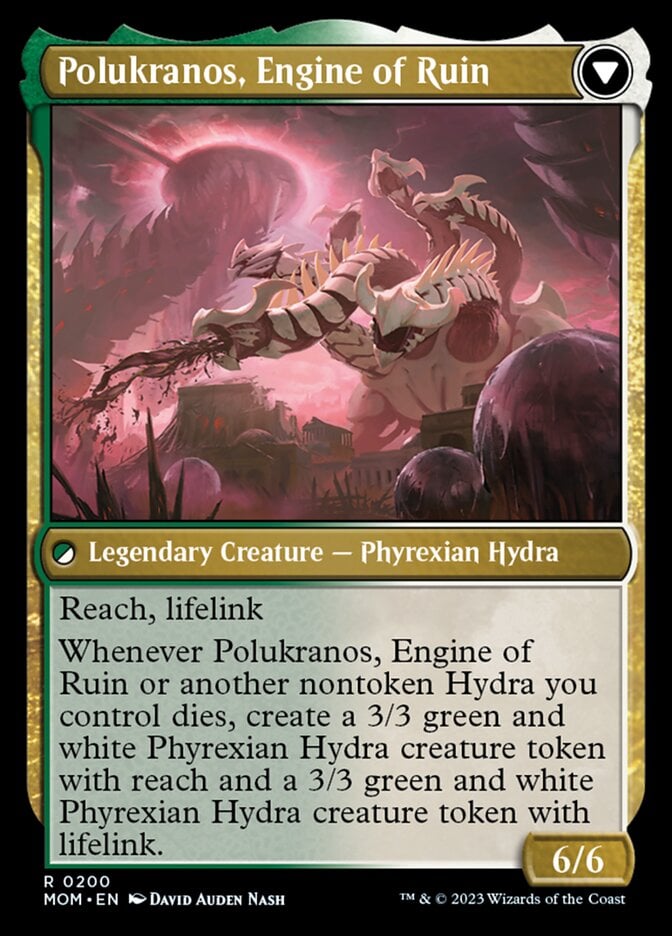
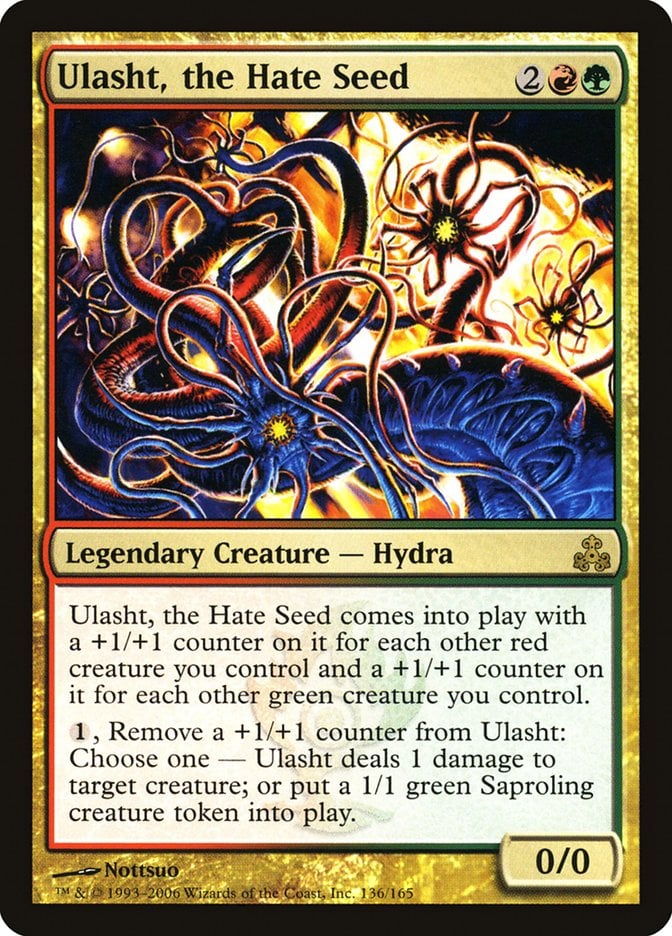

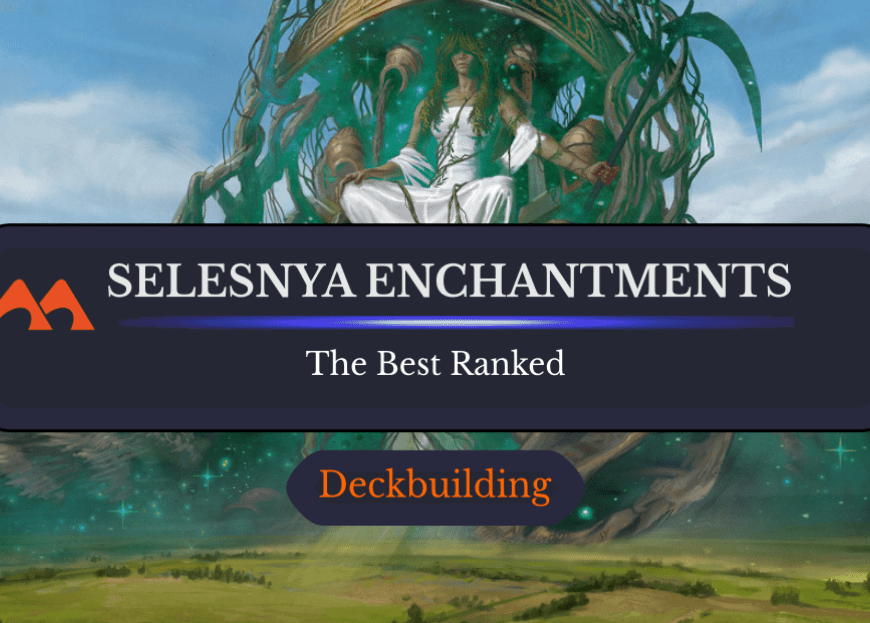
2 Comments
I miss one of my favorites: primordial hydra
I have heard nothing but bad things about Heroes Bane, but I went ahead and tried him out in my Vorinclex, MR +1/+1 Counters deck, and was pleasantly surprised at how good he was at hoovering up removal.
5 mana for something that’s only 8/8 due to your commander sounds terrible, but with a Doubling Season, Primal Vigor, or Branching Evolution out?
Pow, instant removal before untap. That kind of guaranteed removal lightning-rod has value.
Add Comment